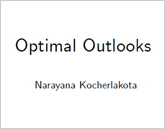Note1
Basic economics says that a policymaker should set a policy instrument so that, on the margin, there is no net benefit to altering it. But while the policymaker’s decision is necessarily made today, the resultant costs and benefits are realized only in the future. Therefore, the policymaker’s optimal choice is to set the policy instrument so that the outlook for the future marginal net benefit is zero. In this talk, I address the following question: How can the policymaker formulate the needed outlook for marginal net benefits? Policymakers often attempt to do so by using statistical models to forecast future marginal net benefits. I argue that policymakers can achieve better outcomes by basing their outlooks on risk-neutral probabilities derived from the prices of financial derivatives.
The benefit of using risk-neutral probabilities arises from the observation that resources may be more valuable in one state of the world relative to another, equally likely, state of the world. (For example, the economy might be in a deep recession in the former state and in a boom in the latter.) In weighing future costs and benefits, the policymaker should take account of this differential valuation of resources in different states. Because they are derived from market prices, risk-neutral probabilities provide the needed information about the relative values of resources in different states of the world in a way that purely statistical forecasts cannot.
After presenting my general argument, I illustrate it using the example of a macro-prudential supervisor who is considering whether to allow systemically important financial institutions to pay dividends. A current dividend payment may generate future social losses if financial markets are strained in that future. Hence, the supervisor’s decision must be based on an outlook for future financial market stress. The above argument implies that the requisite outlook should incorporate the relative costs of resource losses in different states of the world.
The Federal Reserve Bank of Minneapolis reports measures of risk-neutral probabilities on its website. These reports are based on a variety of option prices and are updated every two weeks.
Endnotes
1 I am speaking for myself today, and not for others in the Federal Reserve or on the Federal Open Market Committee.



